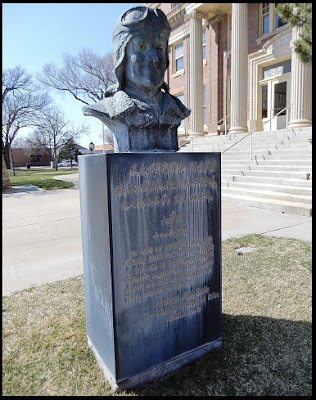Until this trip all I knew about the XIT Ranch
was that at one time it had
been the largest spread in Texas. I didn’t know
that two men got all of the land by supplying the stone for and building of the
state capitol, nor did I know that there were so many little towns that
originated as business centers for the ranch. There’s lots more to learn, and
not just about ranching in Texas.
Dallam County was formed in 1876 from portions of Bexar County – does this sound familiar? This county was named for James Wilmer Dallam, the lawyer who compiled A Digest of the Laws of Texas; Containing a Full and Complete Compilation of the Land Laws; Together with the Opinions of the Supreme Court. Although it was first printed in 1845 (and reprinted several times since), it is still important because present-day Texas
jurisdiction is based on the early laws of
the Republic…but I digress. The first settlement in the area that would be
Dallam County was founded in 1870, and of course that really displeased the
folks already living there, the Comanche and Kiowa tribes. The resulting
battles of the Red
River War in 1874 – 1875 resulted in the tribes being driven out of the
area and confined on reservations. About 16 years later the area began to
prosper when the Fort Worth and Denver Railway lines met in a spot that was to
be named Texline, because it was on the rail line; it was the only actual town
in the county. Ten years later, when the Rock Island Railroad built a line
through the county, the new town of Dalhart was established where the Rock
Island and Fort Worth and Denver City rail lines crossed. The town name was taken
from the first letters of Dallam County and Hartley County – the town sat on
the line between the two. Dalhart was listed
as the county seat in 1903. And the area rocked along just fine until the 1930s
brought the Great
Depression. Dallam County was one of the hardest hit areas with Dalhart the
center of the Dust Bowl;
this locale was adversely affected by three waves of drought and dust storms
covering 1934, 1936 and 1939 – 1940. The people were also preyed upon by such charlatans
as Tex
Thornton, who enticed them to spend $1 million (inflation-adjusted for current
equivalent) to make rain by firing rocket-powered explosives into the clouds.
Dalhart has had three county courthouses. The first was built in Texline in
1891 and doesn’t appear to still exist. The
second was actually constructed in Dalhart in 1903, but rather quickly became obsolete.
The present Dallam County Courthouse, completed in 1923, was designed by the architectural
firm of Smith & Townes in the Classical
Revival style with Ionic columns using brick and cast stone. It was named a
Texas
Historic Landmark in 1991. On the courthouse grounds is a monument to James
R. Fox, Jr. (March 16, 1919—March 11, 1943). He flew supplies to China
during the War
of Resistance against Japanese Aggression for Pan American
Airways (at the time a joint Chinese and American company) using the dangerous
Hump Route.
Fox and his two Chinese copilots were killed when their Douglas C-52 cargo
plane crashed during their support efforts.
©2019 NearNormal Design and Production Studio - All rights including copyright of photographs and designs, as well as intellectual rights are reserved.
 |
| XIT Ranch Museum |
Dallam County was formed in 1876 from portions of Bexar County – does this sound familiar? This county was named for James Wilmer Dallam, the lawyer who compiled A Digest of the Laws of Texas; Containing a Full and Complete Compilation of the Land Laws; Together with the Opinions of the Supreme Court. Although it was first printed in 1845 (and reprinted several times since), it is still important because present-day Texas
 |
| Sand dunes near a rail line |
Dalhart has had three county courthouses. The first was built in Texline in
 |
| Dallam County Courthouse, front and side views |
 |
| James R. Fox, Jr. |
©2019 NearNormal Design and Production Studio - All rights including copyright of photographs and designs, as well as intellectual rights are reserved.
No comments:
Post a Comment